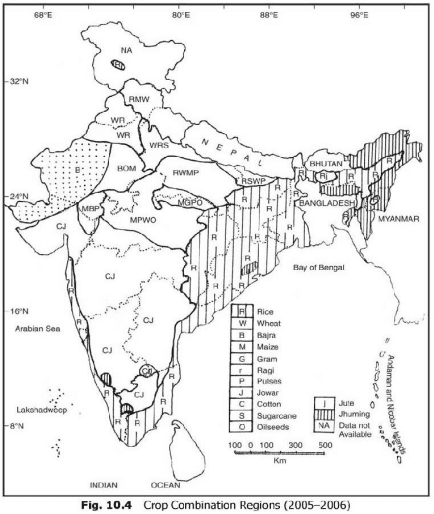Crop Combination
- Crop combination refers to the aggregate of various crops grown/cultivated in an area at a given point of time.
- Crop combination is the analysis of the total percentage acreage area occupied by different crops in a given region in an agricultural year.
- The study of crop combinations constitutes an important aspect of agriculture.
- It provides a good basis for agricultural regionalization and helps in the formulation of strategy for agricultural development.
- Crops are generally grown in combinations and it is rarely that a particular crop occupies a position of total isolation.
- The distribution maps of crops and their concentration are interesting and help in knowing the density and concentration of individual crops, but it is even more important to view the integrated assemblage of the various crops in a region.
- For example, the demarcation of India into rice or wheat region does not explain the agriculturally significant fact that very often the wheat/rice region also has mustard, gram, pulses, and maize.
Calculation Of Crop Combination
- For a comprehensive and clear understanding of the agricultural mosaic of a region, a systemic study of the crop combinations has great planning significance. The methods applied for the demarcation of crop combination regions may be summed up under two categories:
- The arbitrary choice method
- The statistical method
The Arbitrary Choice Method
- In the arbitrary choice method, the first two or the first three crops in the area are included and the rest of the crops are excluded from the combination. This is an unscientific method as the crops are excluded from the combination without any consideration of their percentage area and their monetary value.
The Statistical Method
- This method being based on the statistical formula is more scientific and reliable for the objective grouping of crops.
- In the field of agricultural geography, Weaver (1954) was the first to use the statistical techniques for the demarcation of crop combination regions of the Middle West (USA).
- In his attempt to demarcate the agricultural regions of the Middle West (USA), Weaver based his analysis on acreage statistics.
- Weaver computed the percentage of total harvested cropland occupied by each crop that held as much as one percent of the total cultivated land in each of the 1081 counties covered in his research work.
- He devised a rigorous approach that would provide an objective, constant, and precisely repeatable procedure and would yield comparable results for different years and localities.
- In his work, Weaver calculated deviation of the real percentages of crops (occupying one percent of the cropped area) for all the possible combinations in the component areal units against a theoretical curve for the standard measurement was employed as follows:

- For the determination of the minimum deviation the standard deviation method was used:

- Where‘d’ is the difference between the actual crop percentage in a given country (areal unit) and the appropriate percentage in the theoretical curve and ‘n’ is the number of crops in a given combination.
- As Weaver pointed out, the relative, not absolute, the value being significant, square roots were not extracted; so the actual formula used was as follows:

- To illustrate Weaver’s technique an illustration can be given from the Gorakhpur district where the percentage share of crops in the total harvested area in a year was as follows: rice-48 percent, wheat-23 percent, barley-15 percent, sugarcane- 6 percent, and pulses-5 percent.

- The deviation of the actual percentage from the theoretical curve is seen to be the lowest for a 3-crop combination. This result established the identity and the number of crops in the basic combination for the district of Gorakhpur as rice-wheat and barley.
- Weaver’s technique when applied at the district level for the data of 2003-06 gives the following eight-crop combinations to India.
- An examination shows that the lower Brahmaputra Valley, West Bengal, Odisha, and coastal Andhra Pradesh has the monoculture of rice while in Western Rajasthan, Bajra is the dominant crop.
- In Punjab and Haryana rice and wheat enter into the combination and in western Uttar Pradesh wheat, rice, and sugarcane constitute the combination.
- In the remaining parts of the country, crop combinations vary between four to eight. In these combinations, wheat, rice, maize, gram, barley, ragi, pulses, oilseeds, cotton, sugarcane, bajra, and millets from different crop associations.
- Weaver’s method has admirably been accepted and applied for the demarcation of crop combination regions as its application results into the suitable and accurate grouping of crops. The technique, however, gives the most unwieldy combinations for the units of high crop diversification. This method, however, suffers from the setback of laborious calculations.
Crop Combination Regions in India
- The method of least squares used by J.T. Coppock in 1964 has been employed in ascertaining the crop combination regions.
- There are 11 first ranking crops occupying areas large enough to merit-separate treatment; i.e. rice, wheat, jowar, maize, bajra, ragi, gram, pulse, sugarcane, cotton, oilseed.
- The first ranking crops are those crops that occupy the highest percentage of the cropped areas in the component areal unit.
- Thus India has been divided into 11 crop zones or regions of the first order. The crop zones thus derived have been sub-divided into dominant crop combination regions; to bring out the agricultural land use of the transitional areas in a more meaningful way.


Thankyou very much 🙂
This is precise and we’ll organised.
Calculation of sd in monoculture is not correct, it’ll be 2704
there are 23regions according to singh and dhillon based on weaver and cappock scheme